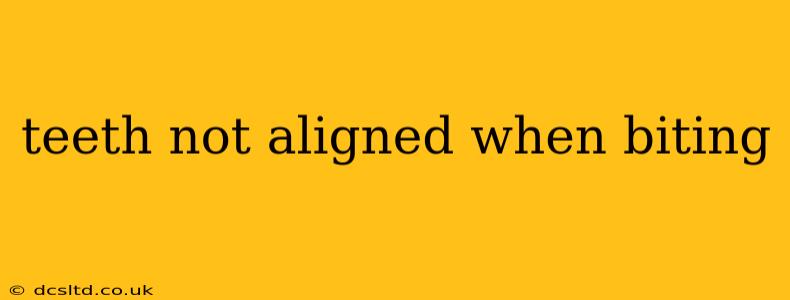Having your teeth not align properly when you bite down, known as malocclusion, is a common issue affecting people of all ages. This condition can range from mildly noticeable to significantly impacting your bite, chewing, and even your appearance. Understanding the causes, types, and treatment options is crucial for addressing this dental concern.
What Causes Teeth Not Aligning When Biting?
Several factors contribute to malocclusion. These can be genetic, developmental, or the result of habits:
-
Genetics: Inheritance plays a significant role. If your parents or other family members had misaligned teeth, you're more likely to experience it as well. Genetic factors influence jaw size and shape, impacting tooth positioning.
-
Developmental Issues: Problems during tooth development, such as overcrowding due to too many teeth or too small a jaw, can lead to misalignment. Early childhood habits like prolonged thumb-sucking can also significantly impact tooth alignment.
-
Injury: Trauma to the mouth, particularly to the jaw or teeth, can displace teeth and cause misalignment. This is especially true in children whose jaws and teeth are still developing.
-
Habits: Grinding your teeth (bruxism) and other habits like tongue thrusting (pressing the tongue against the teeth) can put pressure on teeth and gradually affect their alignment.
What are the Different Types of Malocclusion?
Malocclusion is broadly categorized into different types, each with specific characteristics:
-
Overbite (Overjet): The upper teeth extend significantly over the lower teeth, often creating a pronounced projection of the upper jaw.
-
Underbite: The lower teeth extend beyond the upper teeth, creating a protruding lower jaw.
-
Crossbite: The upper teeth bite inside the lower teeth, instead of overlapping them. This can be unilateral (affecting one side) or bilateral (affecting both sides).
-
Open Bite: A gap exists between the upper and lower teeth when biting down, preventing proper contact.
-
Crowding: Teeth are tightly packed together, leading to overlapping and misalignment.
What are the Symptoms of Malocclusion?
Beyond the visible misalignment, several symptoms can indicate malocclusion:
-
Difficulty Chewing: Improper bite alignment makes it harder to chew food effectively.
-
Jaw Pain: Misalignment can strain the jaw muscles and joints, leading to pain and discomfort, especially with prolonged chewing or jaw movement.
-
Headaches: In some cases, malocclusion can contribute to headaches, particularly tension headaches.
-
Speech Problems: In severe cases, misaligned teeth can interfere with speech articulation.
How is Malocclusion Diagnosed?
A dentist or orthodontist will diagnose malocclusion through a thorough examination. This involves:
-
Visual Inspection: Assessing the alignment of the teeth and jaw.
-
X-rays: Providing detailed images of the teeth, jawbones, and surrounding structures to identify underlying issues.
-
Models: Creating impressions of your teeth to produce plaster models for detailed analysis.
What are the Treatment Options for Misaligned Teeth?
Treatment options depend on the severity and type of malocclusion, as well as the patient's age. Common treatments include:
-
Braces (Traditional or Invisalign): These are the most common treatment for correcting misaligned teeth. Braces gradually reposition teeth into their proper alignment using brackets and wires (traditional braces) or clear aligners (Invisalign).
-
Retainers: Used after braces or other treatments to maintain the corrected alignment.
-
Jaw Surgery (Orthognathic Surgery): In some cases, severe jaw misalignment requires surgical intervention to correct the skeletal structure.
How Much Does Malocclusion Treatment Cost?
The cost of treatment varies significantly depending on the complexity of the case, the type of treatment chosen, and the orthodontist's fees. It's best to consult with an orthodontist for a personalized cost estimate.
Can Malocclusion be Prevented?
While genetics play a role, some preventative measures can help reduce the risk of malocclusion:
-
Good Oral Hygiene: Maintaining excellent oral hygiene practices helps prevent tooth decay and gum disease, which can affect tooth alignment.
-
Healthy Diet: A nutritious diet supports healthy tooth and jaw development.
-
Avoiding Harmful Habits: Discouraging habits like thumb-sucking and nail-biting can prevent negative impacts on tooth alignment.
-
Regular Dental Checkups: Early detection and intervention can help prevent minor misalignments from becoming major problems.
This information is for general knowledge and does not constitute medical advice. Always consult with a dental professional for diagnosis and treatment of any dental condition.
